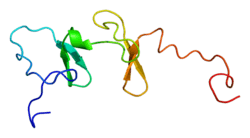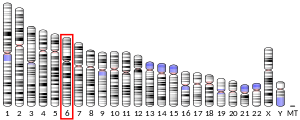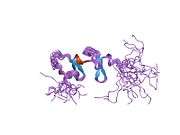FHL5
Four and a half LIM domains protein 5 is a protein that in humans is encoded by the FHL5 gene.[5]
| FHL5 | |||||||||||||||||||||||||
|---|---|---|---|---|---|---|---|---|---|---|---|---|---|---|---|---|---|---|---|---|---|---|---|---|---|
 | |||||||||||||||||||||||||
| |||||||||||||||||||||||||
| Identifiers | |||||||||||||||||||||||||
| Aliases | FHL5, ACT, dJ393D12.2, 1700027G07Rik, FHL-5, four and a half LIM domains 5 | ||||||||||||||||||||||||
| External IDs | OMIM: 605126 MGI: 1913192 HomoloGene: 23230 GeneCards: FHL5 | ||||||||||||||||||||||||
| |||||||||||||||||||||||||
| |||||||||||||||||||||||||
| |||||||||||||||||||||||||
| |||||||||||||||||||||||||
| Orthologs | |||||||||||||||||||||||||
| Species | Human | Mouse | |||||||||||||||||||||||
| Entrez | |||||||||||||||||||||||||
| Ensembl | |||||||||||||||||||||||||
| UniProt | |||||||||||||||||||||||||
| RefSeq (mRNA) | |||||||||||||||||||||||||
| RefSeq (protein) | |||||||||||||||||||||||||
| Location (UCSC) | Chr 6: 96.56 – 96.62 Mb | Chr 4: 25.2 – 25.24 Mb | |||||||||||||||||||||||
| PubMed search | [3] | [4] | |||||||||||||||||||||||
| Wikidata | |||||||||||||||||||||||||
| |||||||||||||||||||||||||
Function
The protein encoded by this gene is coordinately expressed with activator of cAMP-responsive element modulator (CREM). It is associated with CREM and confers a powerful transcriptional activation function. CREM acts as a transcription factor essential for the differentiation of spermatids into mature spermatozoa. There are multiple polyadenylation sites found in this gene.[5]
Interactions
FHL5 has been shown to interact with CREB1[6] and CAMP responsive element modulator.[6][7]
References
- GRCh38: Ensembl release 89: ENSG00000112214 - Ensembl, May 2017
- GRCm38: Ensembl release 89: ENSMUSG00000028259 - Ensembl, May 2017
- "Human PubMed Reference:". National Center for Biotechnology Information, U.S. National Library of Medicine.
- "Mouse PubMed Reference:". National Center for Biotechnology Information, U.S. National Library of Medicine.
- "Entrez Gene: FHL5 four and a half LIM domains 5".
- Fimia GM, De Cesare D, Sassone-Corsi P (November 2000). "A family of LIM-only transcriptional coactivators: tissue-specific expression and selective activation of CREB and CREM". Mol. Cell. Biol. 20 (22): 8613–22. doi:10.1128/MCB.20.22.8613-8622.2000. PMC 102166. PMID 11046156.
- Fimia GM, De Cesare D, Sassone-Corsi P (March 1999). "CBP-independent activation of CREM and CREB by the LIM-only protein ACT". Nature. 398 (6723): 165–9. doi:10.1038/18237. PMID 10086359.
Further reading
- Fimia GM, Morlon A, Macho B, De Cesare D, Sassone-Corsi P (2001). "Transcriptional cascades during spermatogenesis: pivotal role of CREM and ACT". Mol. Cell. Endocrinol. 179 (1–2): 17–23. doi:10.1016/S0303-7207(01)00463-4. PMID 11420126.
- Maruyama K, Sugano S (1994). "Oligo-capping: a simple method to replace the cap structure of eukaryotic mRNAs with oligoribonucleotides". Gene. 138 (1–2): 171–4. doi:10.1016/0378-1119(94)90802-8. PMID 8125298.
- Suzuki Y, Yoshitomo-Nakagawa K, Maruyama K, Suyama A, Sugano S (1997). "Construction and characterization of a full length-enriched and a 5'-end-enriched cDNA library". Gene. 200 (1–2): 149–56. doi:10.1016/S0378-1119(97)00411-3. PMID 9373149.
- Fimia GM, De Cesare D, Sassone-Corsi P (1999). "CBP-independent activation of CREM and CREB by the LIM-only protein ACT". Nature. 398 (6723): 165–9. doi:10.1038/18237. PMID 10086359.
- Fimia GM, De Cesare D, Sassone-Corsi P (2000). "A family of LIM-only transcriptional coactivators: tissue-specific expression and selective activation of CREB and CREM". Mol. Cell. Biol. 20 (22): 8613–22. doi:10.1128/MCB.20.22.8613-8622.2000. PMC 102166. PMID 11046156.
- Palermo I, Litrico L, Emmanuele G, Giuffrida V, Sassone-Corsi P, De Cesare D, Maria Fimia G, D'Agata R, Calogero AE, Travali S (2001). "Cloning and expression of activator of CREM in testis in human testicular tissue". Biochem. Biophys. Res. Commun. 283 (2): 406–11. doi:10.1006/bbrc.2001.4805. PMID 11327716.
- Peri A, Luciani P, Tonacchera M, Agretti P, Baglioni-Peri S, Buci L, Conforti B, Cioppi F, Biliotti G, Serio M, Vitti P, Chiovato L (2002). "Expression of cAMP-responsive element binding protein and inducible cAMP early repressor in hyperfunctioning thyroid adenomas". Eur. J. Endocrinol. 146 (6): 759–66. doi:10.1530/eje.0.1460759. PMID 12039695.
- Macho B, Brancorsini S, Fimia GM, Setou M, Hirokawa N, Sassone-Corsi P (2002). "CREM-dependent transcription in male germ cells controlled by a kinesin". Science. 298 (5602): 2388–90. doi:10.1126/science.1077265. PMID 12493914.
- Philippar U, Schratt G, Dieterich C, Müller JM, Galgóczy P, Engel FB, Keating MT, Gertler F, Schüle R, Vingron M, Nordheim A (2004). "The SRF target gene Fhl2 antagonizes RhoA/MAL-dependent activation of SRF". Mol. Cell. 16 (6): 867–80. doi:10.1016/j.molcel.2004.11.039. hdl:1721.1/83480. PMID 15610731.
- Barrios-Rodiles M, Brown KR, Ozdamar B, Bose R, Liu Z, Donovan RS, Shinjo F, Liu Y, Dembowy J, Taylor IW, Luga V, Przulj N, Robinson M, Suzuki H, Hayashizaki Y, Jurisica I, Wrana JL (2005). "High-throughput mapping of a dynamic signaling network in mammalian cells". Science. 307 (5715): 1621–5. doi:10.1126/science.1105776. PMID 15761153.
- Rual JF, Venkatesan K, Hao T, Hirozane-Kishikawa T, Dricot A, Li N, Berriz GF, Gibbons FD, Dreze M, Ayivi-Guedehoussou N, Klitgord N, Simon C, Boxem M, Milstein S, Rosenberg J, Goldberg DS, Zhang LV, Wong SL, Franklin G, Li S, Albala JS, Lim J, Fraughton C, Llamosas E, Cevik S, Bex C, Lamesch P, Sikorski RS, Vandenhaute J, Zoghbi HY, Smolyar A, Bosak S, Sequerra R, Doucette-Stamm L, Cusick ME, Hill DE, Roth FP, Vidal M (2005). "Towards a proteome-scale map of the human protein-protein interaction network". Nature. 437 (7062): 1173–8. doi:10.1038/nature04209. PMID 16189514.
- Christensen GL, Wooding SP, Ivanov IP, Atkins JF, Carrell DT (2006). "Sequencing and haplotype analysis of the activator of CREM in the testis (ACT) gene in populations of fertile and infertile males". Mol. Hum. Reprod. 12 (4): 257–62. doi:10.1093/molehr/gal006. PMID 16687568.
- Lim J, Hao T, Shaw C, Patel AJ, Szabó G, Rual JF, Fisk CJ, Li N, Smolyar A, Hill DE, Barabási AL, Vidal M, Zoghbi HY (2006). "A protein-protein interaction network for human inherited ataxias and disorders of Purkinje cell degeneration". Cell. 125 (4): 801–14. doi:10.1016/j.cell.2006.03.032. PMID 16713569.
External links
- FHL5+protein,+human at the US National Library of Medicine Medical Subject Headings (MeSH)
This article incorporates text from the United States National Library of Medicine, which is in the public domain.
This article is issued from Wikipedia. The text is licensed under Creative Commons - Attribution - Sharealike. Additional terms may apply for the media files.





